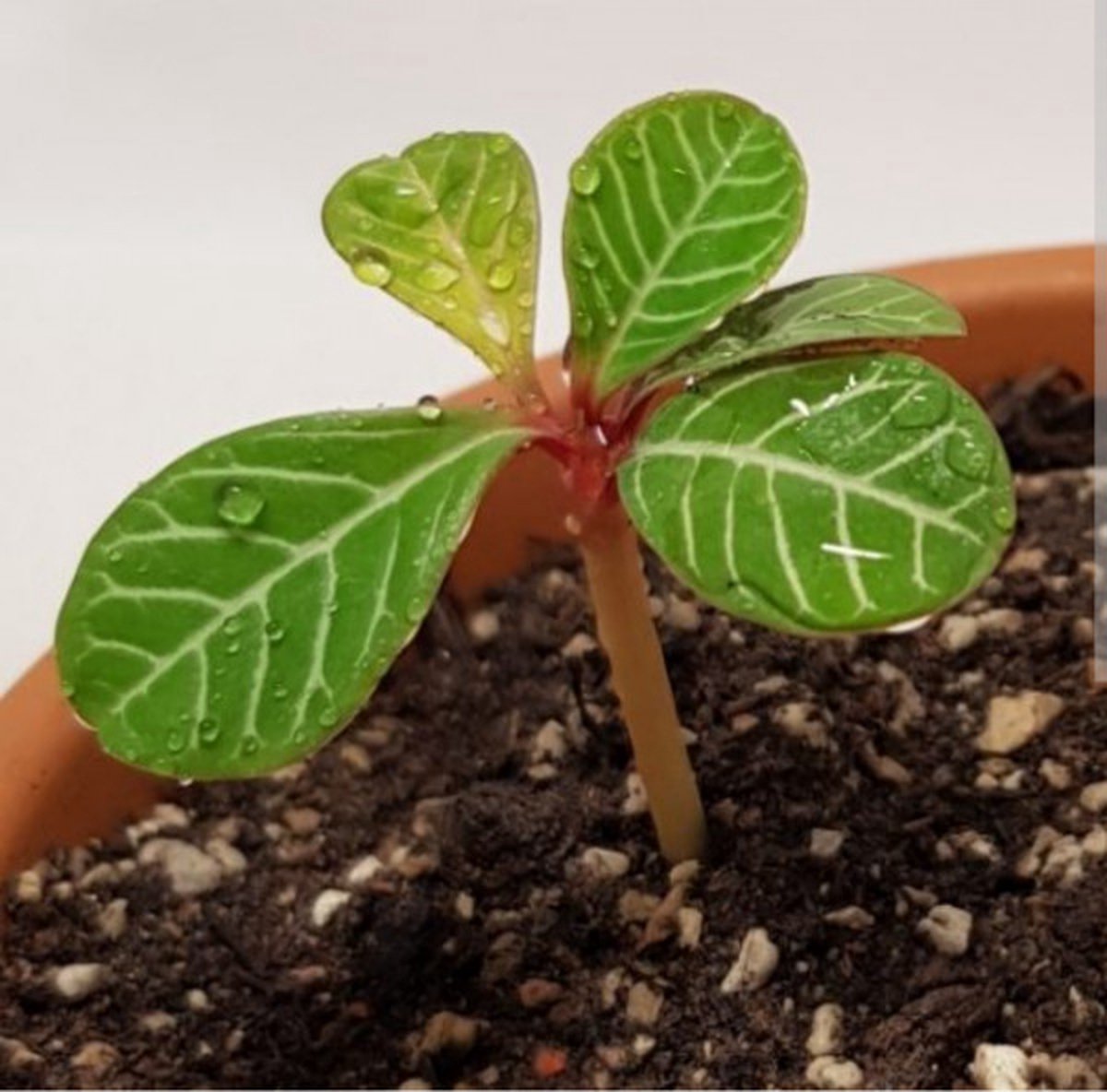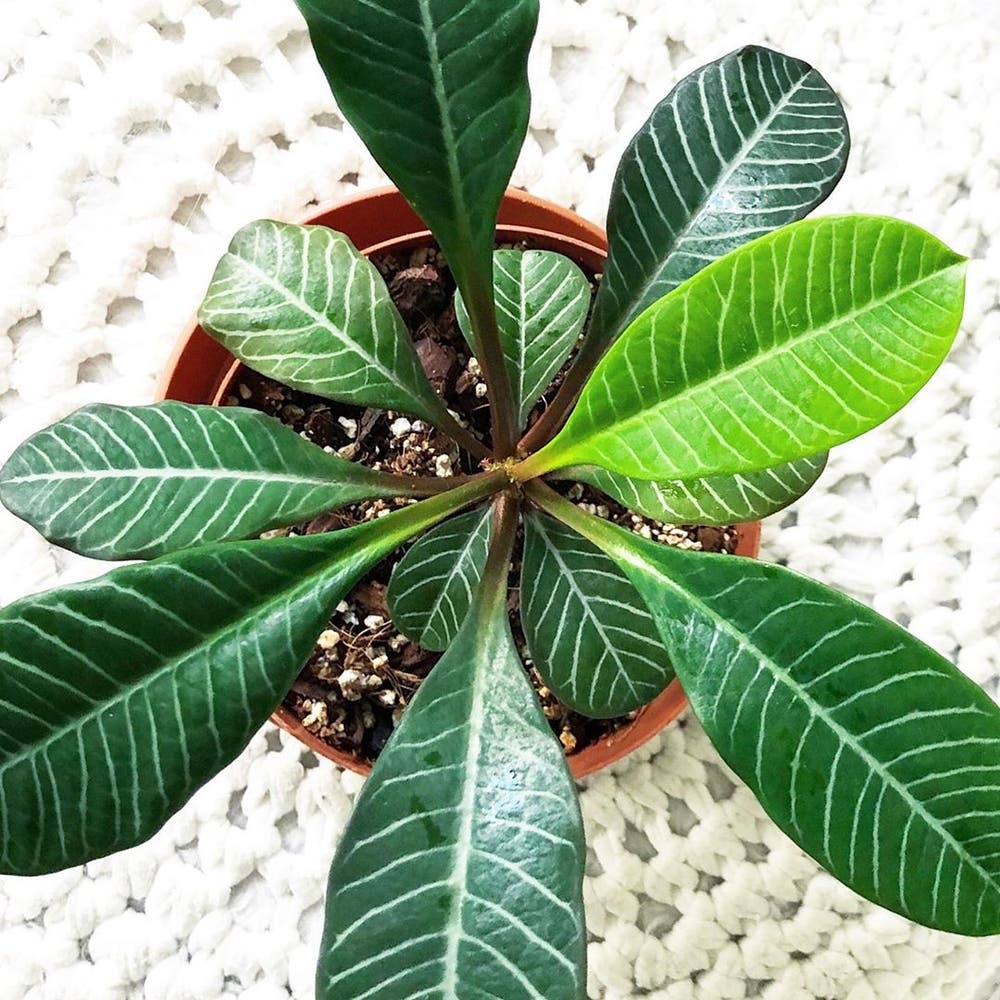
Madagascar Jewel & kopen met 9 effectieve tips!
It prefers temperatures between 65°F and 80°F (18°C-27°C). Avoid placing it near drafts or air conditioning vents that may cause temperature fluctuations. Additionally, this plant appreciates higher humidity levels, so misting the leaves regularly or placing a tray filled with water near the plant can help maintain adequate moisture levels.

Madagascar Jewel The PassAlong Succulent Laidback Gardener
Madagascar Jewel needs 0.8 cups of water every 12 days when it doesn't get direct sunlight and is potted in a 5.0" pot. Use our water calculator to personalize watering recommendations to your environment or download Greg for more advanced recommendations for all of your plants. Water 0.8 cups every 12 days Does your plant get direct sunlight?
Polynesian Produce Stand Madagascar Jewel Euphorbia leuconeura Unique Bonsai Palmlike Live
The Madagascar Jewel (Euphorbia leuconeura) grows in the undergrowth of the forests in Northern Madagascar on rocky soil. With its succulent stem, it grows into a shrub of 6-8 ft (1-2 m) and prefers bright indirect light as well as regular watering. As for maintenance, the Madagascar Jewel is very tolerant.

Madagascar jewel care, habitat & toxicity Plantura
Madagascar jewel ( Euphorbia leuconeura) is an upright and mostly unbranched shrub. It is exclusively native to northern Madagascar, hence its name. In nature, it reaches up to two metres tall. It can also be grown indoors as a houseplant, where it generally grows up to one metre tall.
Polynesian Produce Stand Madagascar Jewel Euphorbia leuconeura Unique Bonsai Palmlike Live
Madagascar Jewel Latin name: Euphorbia leuconeura About me: I have attractive, dark green foliage, with white veins when young. These will fade a little as I age but by that point I'll be so impressively bushy you won't mind at all! Useful to know: Origin I'm from Madagascar of course! Height/Growth I can grow up to 1.8 metre in height! Light

Madagascar Jewel (Euphorbia leuconeura) in the Euphorbias Database
Pops open explosively when ripe. Flowers: Inconspicuous. Other: In the genus Euphorbia, the flowers are reduced in size and aggregated into a cluster of flowers called a cyathium (plural cyathia). This feature is present in every species of the genus Euphorbia but nowhere else in the plant kingdom. Flower Color: Other: Reddish brown. Bloom Size:

MADAGASCAR JEWEL ZADEN Planten wereld www.plantenwereld.nl
De bijnaam, Madagascar Jewel, dankt de plant aan het feit dat deze afkomstig is uit, je raad het al, Madagascar. Daar groeit deze plant in de oerwouden onder tropische omstandigheden. In dit klimaat kan de plant hoogtes bereiken tot wel drie meter! Gelukkig doet hij het ook goed in ons koude kikkerlandje.

Madagascar Jewel Euphorbia SEEDS Etsy
The Madagascar Jewel plant can grow up to 2 feet tall, making it an excellent addition to both indoor and outdoor gardens. 2. Low Maintenance. For those who have limited time or lack gardening experience, the Madagascar Jewel plant is an ideal choice. This succulent requires minimal care and attention, making it perfect for busy individuals or.

Euphorbia Leuconeura zaden (5 stuks) Jewel of Madagascar Unieke plant soort
The Madagascar Jewel, also known by its scientific name Euphorbia Leuconeura, is a beautiful succulent plant that originates from the island of Madagascar. As its name suggests, the Madagascar Jewel is a jewel among plants! This plant is a member of the Euphorbiaceae family and its more common name is the Madagascar Jewel.

Euphorbia Leuconeura zaden (10 stuks) Jewel of Madagascar Unieke plant soort
Stage 3: Maturity. As the Madagascar Jewel Plant matures, it starts producing more leaves and becomes bushier. The leaves grow larger than those in the juvenile stage but still retain their characteristic shape and pattern. At this stage, the plant may also start producing small clusters of inconspicuous flowers, primarily in the summer months.

Madagascar Jewel Care 101 Water, Light & Growing Tips
Bekijk ze nu! Madagascar Jewel (Euphorbia Leuconeura) stekken: hoe moet het? Je kunt deze plant op 2 manieren stekken: Door te wachten totdat de plant zelf zaden heeft ontwikkeld Door een blad af te snijden en deze op water te zetten Een Madagascar Jewel plant ontwikkeld zelf zaden Deze zaden bouwen zich op in het midden van de plant.

Madagascar Jewel The PassAlong Succulent Laidback Gardener
A Guide to Poisonous Houseplants. Here is a picture of a Madagascar Jewel plant in bloom. A Madagascar Jewel plant is a unique, flowering, succulent plant with a square stem. Read care tips on how to to grow this plant at Houseplant411.com.

a plant with green leaves and red flowers in the background
The Madagascar Jewel plant, or Euphorbia leuconeura, is a unique and fascinating houseplant that can make a stunning addition to any indoor space. With its attractive foliage and low-maintenance nature, it is no wonder that this plant has gained popularity among houseplant enthusiasts. However, like any other plant, the Madagascar Jewel.

Madagascar Jewel The PassAlong Succulent Laidback Gardener
The Madagascar Jewel. The Madagascar Jewel will grow to a height of 1.8 m as a branching small tree, and propagates by shooting its seeds several feet into the air. It is commonly grown as a houseplant for its attractive foliage with dark green leaves, with white veins when young. Best to avoid cold drafts.
Polynesian Produce Stand Madagascar Jewel Euphorbia leuconeura Unique Bonsai Palmlike Live
Background E. leuconeura is a succulent shrub, even a small tree, reaching to 1.8 m (6 ft) in height. Although commonly mistaken for a cactus, it's actually a member of the euphorbia family (Euphorbiaceae). Juvenile plant with white nerves. Photo: www.kakteen-matk-berlin.de

Madagascar jewel care, habitat & toxicity Plantura
E. leuconeura can be described as a succulent shrub or small tree that grows to heights of 1.8m (6 feet). It is often mistakenly thought to be a cactus, but it is a member of the Euphorbiaceae family. Young plants have tear-shaped leaves and bright white nerves. They also have a reddish petiole.